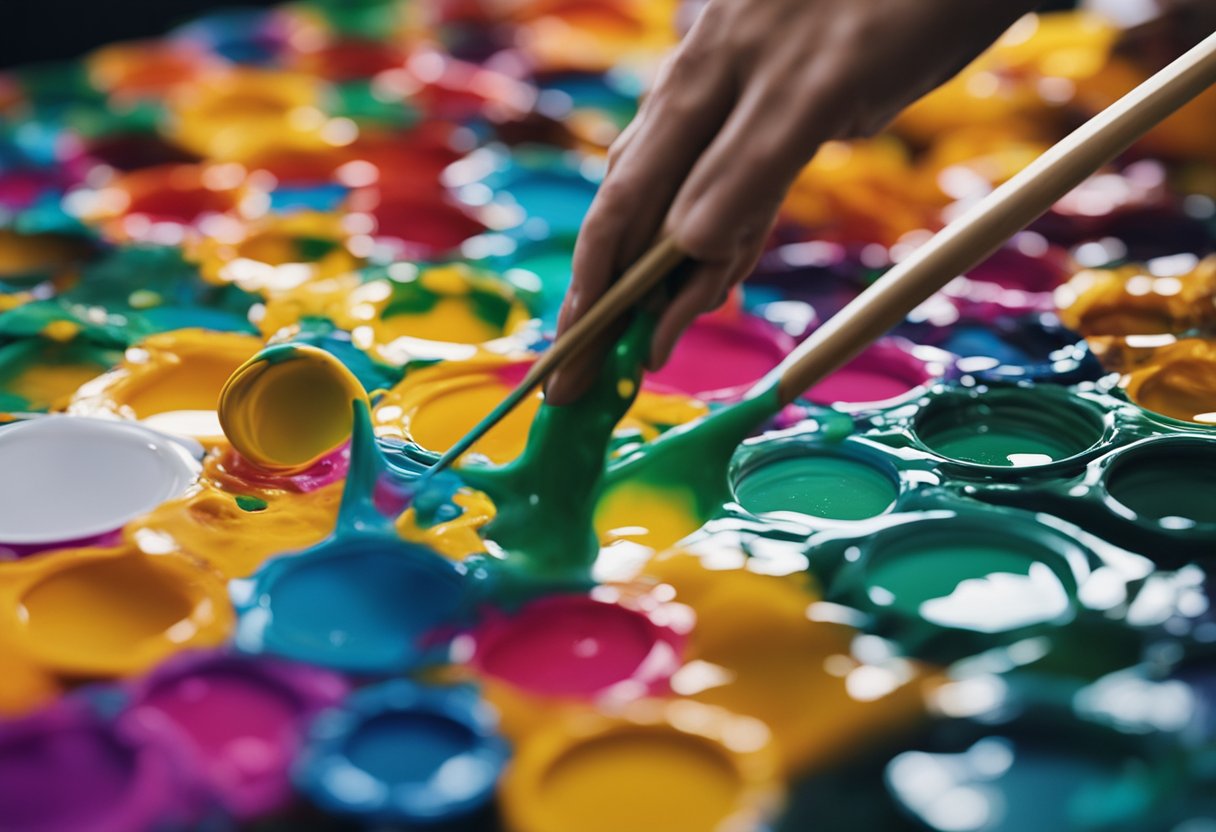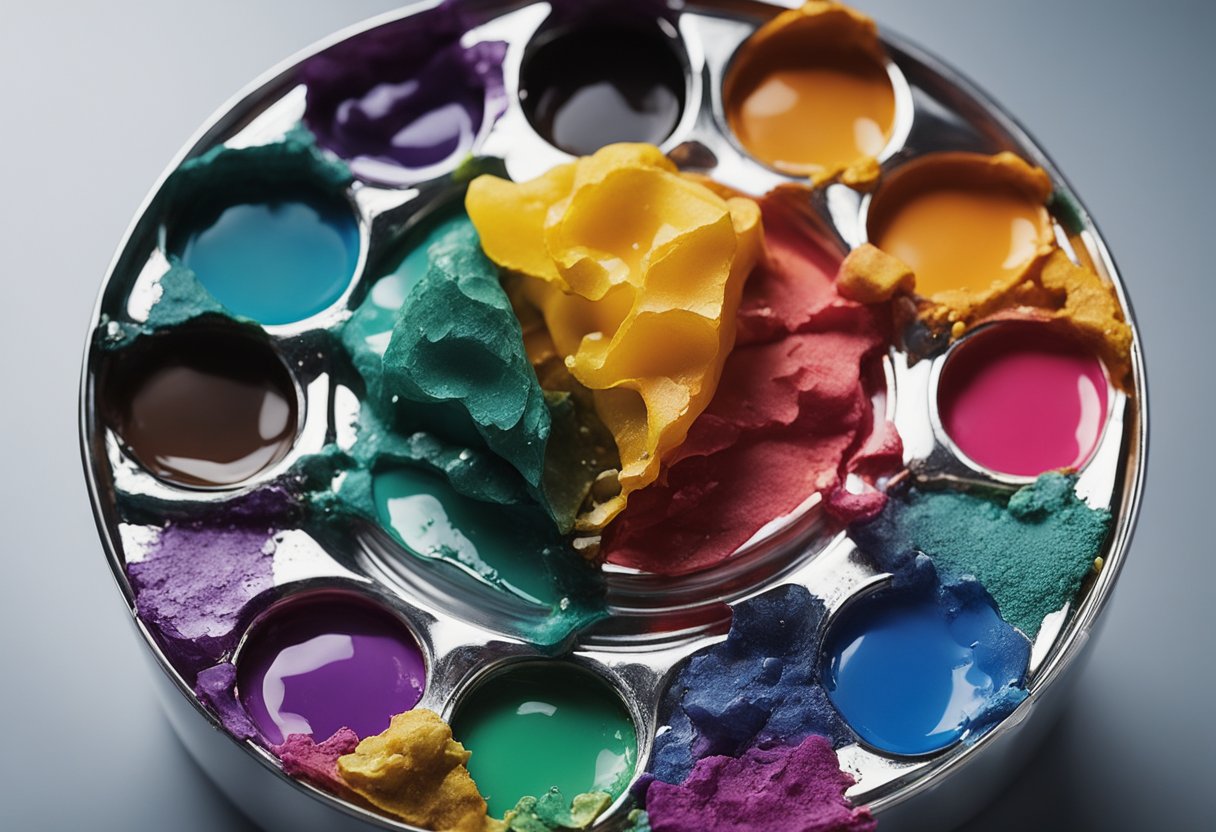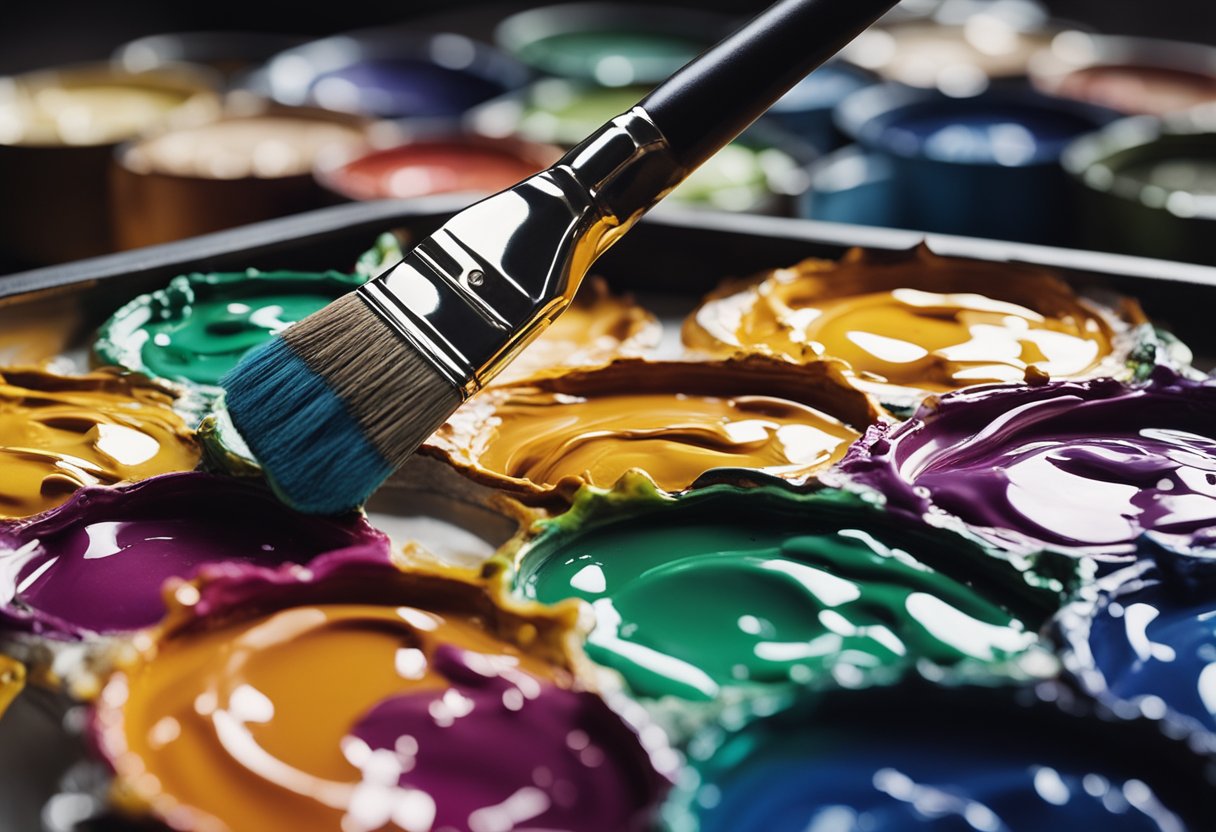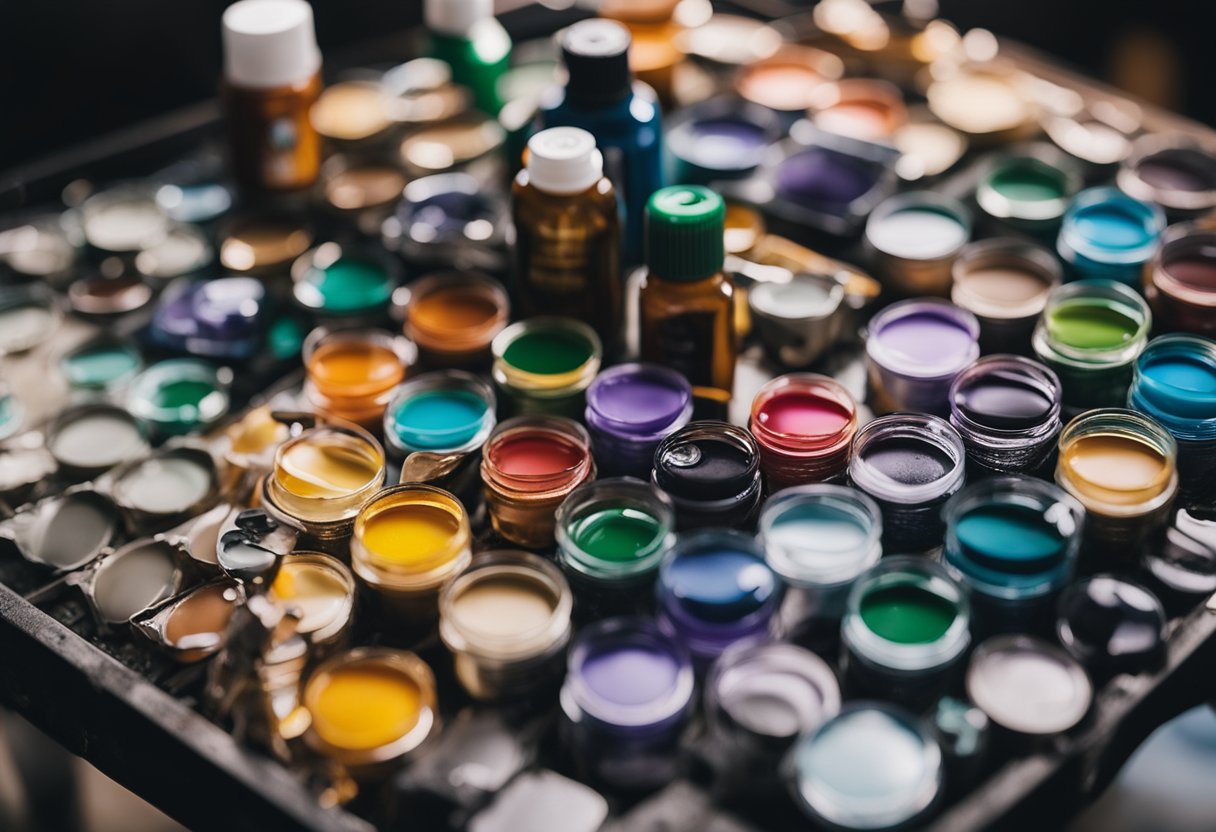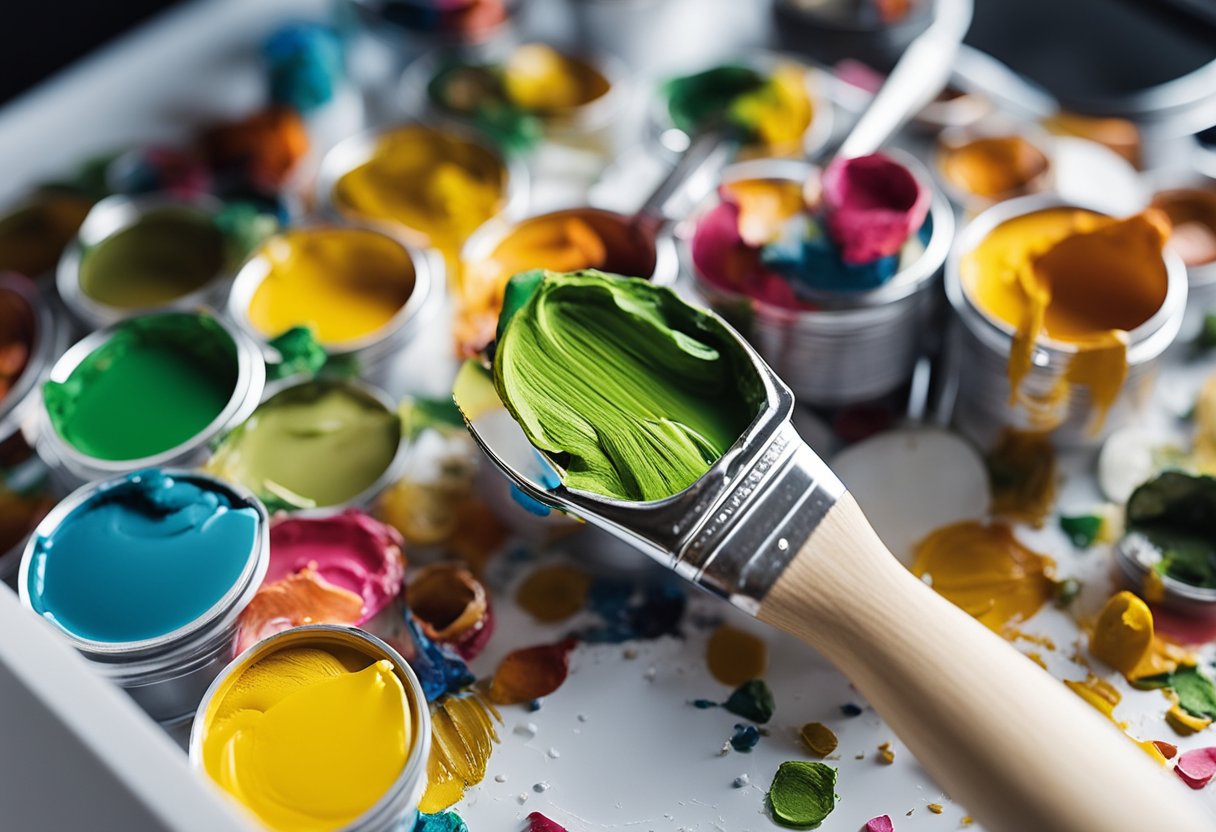As an artist, I know how frustrating it can be to open a tube of acrylic paint only to find it dried out and unusable. However, there are several techniques you can use to revive acrylic paint and extend its lifespan. In this article, I will share my tips and tricks for rehydrating old, dried-out acrylic paint so you can get the most out of your supplies.
Understanding acrylic paint is key to reviving it. Acrylic paint is a water-based paint that contains pigments suspended in an acrylic polymer emulsion. When exposed to air, the water in the paint evaporates, leaving behind a thick, plastic-like film on the surface of the paint. This film makes acrylic paint water-resistant and durable, but it also makes it prone to drying out quickly.
In this article, I will explain why acrylic paint dries out, how to identify dried acrylic paint, and preventive measures you can take to keep your acrylic paint fresh. I will also share several techniques for reviving dried acrylic paint, including using mediums and additives to rehydrate the paint, dealing with specific issues like thick, lumpy, and bad paint, and more.
Key Takeaways
- Acrylic paint is a water-based paint that dries out quickly when exposed to air.
- Techniques for reviving dried acrylic paint include using water or acrylic medium to rehydrate the paint, using specific additives to improve the consistency, and more.
- Preventive measures like sealing your paint and storing it properly can help extend the lifespan of your acrylic paint.
Understanding Acrylic Paint
https://www.youtube.com/watch?v=InT9_lJFHuM&embed=true
As an artist, it is important to understand the properties of acrylic paint to ensure that you can use it to its full potential. Acrylic paint is a water-based paint that is made of pigment particles suspended in an acrylic polymer emulsion. The emulsion acts as a binder that holds the pigment particles together and binds them to the surface when the paint dries.
One of the most significant benefits of acrylic paint is that it is water-resistant when it dries. This property makes it an ideal choice for painting on surfaces that are exposed to the elements, such as outdoor murals or garden ornaments. Acrylic paint is also known for its durability and long-lasting properties, which makes it an excellent choice for paintings that are intended to last for many years.
When it comes to the properties of acrylic paint, there are a few things to keep in mind. Acrylic paint is known for its fast drying time, which means that you need to work quickly when painting with it. However, this property also means that you can layer paint on top of each other without having to wait for the paint to dry completely.
Acrylic paint can also be thinned with water to create a more transparent effect or to create a wash. However, adding too much water can dilute the pigment and compromise the quality of the paint. It is also important to note that acrylic paint can be mixed with other mediums, such as gels or pastes, to create a variety of textures and effects.
In summary, acrylic paint is a versatile and durable medium that is perfect for artists of all levels. Understanding the properties of acrylic paint, such as its water-resistant and fast-drying properties, can help you make the most of this medium and create stunning works of art that will last for years to come.
Why Does Acrylic Paint Dry Out
As an artist, I have often faced the problem of dried-out acrylic paint. It can be frustrating to find that the paint you were planning to use has become unusable. But why does acrylic paint dry out?
Acrylic paint dries out due to evaporation. The water in the paint evaporates into the air, leaving behind the pigment and the binding agent. This process is accelerated by exposure to air, high temperatures, and low humidity. Acrylic paint is also fast-drying, which means that it dries out quickly, especially if left open for long periods.
Temperature and humidity play a crucial role in the drying process of acrylic paint. High temperatures and low humidity can cause the water in the paint to evaporate faster, leading to faster drying times. On the other hand, low temperatures and high humidity can slow down the drying process, making it take longer for the paint to dry.
Exposure to air is another factor that contributes to the drying out of acrylic paint. When the paint is exposed to air, the water in the paint begins to evaporate, leaving behind a thick layer of paint that can become unusable. It is essential to keep the paint container tightly sealed when not in use to prevent exposure to air.
Acrylic paint is also known for its fast-drying properties. While this can be an advantage, it can also be a disadvantage if the paint is left open for too long. Fast-drying paint can dry out quickly, making it unusable if left open for extended periods.
In summary, acrylic paint dries out due to evaporation, exposure to air, high temperatures, low humidity, and fast-drying properties. It is essential to store the paint correctly and use it within the recommended time frame to prevent it from drying out.
Identifying Dried Acrylic Paint
As an artist, it is important to know when your acrylic paint has dried up. This can help you prevent wastage of paint, avoid ruining your artwork, and save you money. Here are a few ways to identify dried acrylic paint:
-
Hardened paint: When acrylic paint dries up, it hardens and forms a plastic-like film on the surface. This makes it difficult to mix or apply the paint. You may also notice that the paint has become lumpy and thick.
-
Separated paint: Dried acrylic paint can separate into two layers, with the pigment settling at the bottom and the binder rising to the top. This can cause the paint to have a strange smell and an uneven texture.
To check if your acrylic paint has dried up, you can:
-
Check the surface: If the surface of the paint is hard and cannot be easily mixed, it is likely that the paint has dried up.
-
Check the consistency: If the paint is lumpy or thick, it may have dried up. You can also check the consistency by pouring the paint onto a palette or canvas. If the paint does not spread easily, it may have dried up.
-
Check the smell: If the paint has a strange smell, it may have separated and dried up.
In conclusion, identifying dried acrylic paint is crucial for any artist who wants to create beautiful and long-lasting artwork. By following the tips above, you can easily identify dried-up acrylic paint and take the necessary steps to revive it.
Preventive Measures to Keep Acrylic Paint Fresh
As an artist, I know how frustrating it can be to have acrylic paint dry out before I’m even finished with a project. That’s why I always take preventive measures to keep my acrylic paint fresh. Here are some tips to help you prevent acrylic paint from drying out:
1. Use Caps and Airtight Containers
When you’re not using your acrylic paint, it’s important to keep it covered. Make sure to put the caps back on your paint tubes tightly to prevent air from getting in. If you’re using jars of acrylic paint, use airtight containers to store them. This will help prevent the paint from drying out and keep it fresh for longer.
2. Use a Stay-Wet Palette
A stay-wet palette is a great tool for keeping acrylic paint fresh. It’s a palette that has a layer of water underneath a layer of paper or sponge. The water keeps the paint moist and prevents it from drying out. You can buy a stay-wet palette or make your own by placing a damp sponge or paper towel in a plastic container and covering it with a sheet of wax paper.
3. Seal Your Paintings
Once you’ve finished a painting, it’s important to seal it to protect it from the elements. Use a varnish or sealant to protect your painting from direct sunlight and extreme temperatures. This will help prevent the paint from cracking or fading over time.
By taking these preventive measures, you can keep your acrylic paint fresh and ready to use for your next project. Remember to always cover your paint when you’re not using it, use a stay-wet palette, and seal your paintings to protect them from the elements.
Techniques to Revive Acrylic Paint
https://www.youtube.com/watch?v=YZgdVX_lZb8&embed=true
As an artist, I have often found myself in situations where my acrylic paint has dried up, and I need to revive it. Fortunately, there are several techniques that I have learned over the years that can help me bring my acrylic paint back to life.
Adding Water
One of the easiest ways to revive acrylic paint is to add water. Acrylic paint is water-soluble, meaning adding water can help thin out the paint and restore its original consistency. I usually start by adding a small amount of water to the paint and mixing it thoroughly. If the paint is still too thick, I keep adding water in small increments until I get the desired consistency.
Using a Spray Bottle
Another technique that I find helpful is using a spray bottle. I fill the spray bottle with warm water and spray a fine mist over the dried paint. I am careful not to saturate the paint, as too much water can dilute the pigment. After spraying water, I use a palette knife to gently mix the moistened paint.
Using Acrylic Paint Thinner
If adding water does not work, I use an acrylic paint thinner. Acrylic paint thinner is a liquid that can help dilute acrylic paint. I add a small amount of the thinner to the dried paint and mix it thoroughly. The paint should start to thin out and become more workable. I continue adding the thinner in small increments until I get the desired consistency.
Using a Palette Knife
A palette knife is a useful tool for reviving acrylic paint. I use a palette knife to scrape off the top layer of the dried paint. Then, I mix the remaining paint with a small amount of water or acrylic paint thinner. I keep mixing until I get the desired consistency.
In conclusion, reviving acrylic paint is not a difficult task. With the right techniques and tools, you can bring your dried-up paint back to life. Adding water, using a spray bottle, using acrylic paint thinner, and using a palette knife are all effective methods for reviving acrylic paint.
Using Mediums and Additives to Rehydrate Acrylic Paint
https://www.youtube.com/watch?v=cZZT3yd1maM&embed=true
When it comes to reviving dried acrylic paint, using mediums and additives can be a great solution. These products are designed to help you adjust the consistency, texture, and flow of your paint, which makes them ideal for rehydrating dried-out paint.
One of the most commonly used mediums for rehydrating acrylic paint is acrylic flow improver. This product is designed to thin out the paint and improve its flow, which can be especially helpful if your paint has dried out and become thick and clumpy. Another popular option is fluid medium, which is similar to acrylic flow improver but has a slightly different consistency.
If you’re looking for a product that can help you create transparent layers and glazes, then glazing liquid is a great option. This product is designed to increase the transparency of your paint and create a smooth, even finish. Similarly, matte medium can be used to create a matte finish on your paint, which can be especially useful if you’re looking to create a more subdued, understated look.
While acrylic mediums are the most common products used for rehydrating acrylic paint, there are other options available as well. For example, you can use oil paints or paint thinner to thin out your paint, although these products may not be as effective as acrylic mediums. Additionally, alcohol or isopropyl alcohol can be used to rehydrate acrylic paint, but it’s important to use them sparingly and with caution, as they can have a negative impact on the quality of your paint.
Overall, using mediums and additives is a great way to rehydrate dried acrylic paint. Whether you’re looking to adjust the consistency of your paint, create transparent layers and glazes, or achieve a matte finish, there are plenty of products available to help you achieve your desired results.
Dealing with Specific Issues: Thick, Lumpy and Bad Paint
https://www.youtube.com/watch?v=sKk0xZLhRLM&embed=true
When it comes to reviving acrylic paint, there are a few specific issues that you might encounter. Thick and lumpy paint can be especially frustrating, but with the right techniques, you can get your paint back to its original consistency.
Thick Paint
If your acrylic paint has become too thick, it can be difficult to work with. One solution is to add water to the paint. Start by adding small amounts of water and mixing it thoroughly. Keep adding water until the paint reaches the desired consistency. Be careful not to add too much water, as this can dilute the pigment and make the paint transparent.
Another solution is to use a medium to thin out the paint. There are many different types of mediums available, including gloss, matte, and satin finishes. Each type of medium has its own unique properties, so be sure to choose one that is appropriate for your project.
Lumpy Paint
Lumpy paint can be caused by a variety of factors, including improper storage, exposure to air, or temperature fluctuations. To fix lumpy paint, start by stirring the paint thoroughly with a palette knife or stirring stick. If the paint is still lumpy, you can strain it through a fine mesh strainer or a piece of cheesecloth. This will help remove any lumps or impurities from the paint.
Bad Paint
If your acrylic paint has gone bad, it may have separated or developed mold growth. In this case, it is best to discard the paint and start with a fresh batch. To prevent your paint from going bad in the future, be sure to store it properly in a cool, dry place and use it within its recommended shelf life.
Overall, reviving acrylic paint is a simple process that can save you time and money. By following these tips for dealing with specific issues like thick, lumpy, and bad paint, you can get the most out of your acrylic paints and create beautiful works of art.
Extending the Lifespan of Acrylic Paint
https://www.youtube.com/watch?v=DNxfIlNsTGE&embed=true
As an artist, I know how frustrating it is to have acrylic paint dry out before I can use it. However, there are a few things you can do to extend the lifespan of your acrylic paint.
Shelf Life
Acrylic paint has a relatively long shelf life compared to other types of paint. However, it is important to store it properly to prevent it from drying out. Keep your acrylic paint in a cool, dry place away from direct sunlight. Avoid storing it in areas with high humidity as this can affect the paint’s consistency.
Prolonging the Lifespan
To prolong the lifespan of your acrylic paint, you can add a few drops of water or acrylic medium to the mixture. Stir well and add more as necessary to achieve the desired consistency. Avoid adding too much water, as this can dilute the pigment and compromise the quality of the paint.
Preventing Drying Out
One of the most effective ways to prevent acrylic paint from drying out is to use airtight containers. You can use empty jars or containers to store your paint. Make sure to label them properly so you can easily identify the color and brand. Another way to prevent drying out is to use a palette with a lid. This will keep your paint moist for longer periods.
Retarders
Retarders are additives that slow down the drying process of acrylic paint. They are useful when working on large paintings or when you need more time to blend colors. However, use them sparingly as they can affect the paint’s consistency and color.
Durable and Long-Lasting
Acrylic paint is known for its durability and long-lasting properties. However, to ensure that your artwork lasts for years, it is important to use high-quality paint and materials. Avoid using low-quality paint or materials as they can affect the longevity of your artwork.
By following these tips, you can extend the lifespan of your acrylic paint and prevent it from drying out too quickly.
Frequently Asked Questions
How can I revive dried acrylic paint in a tube?
To revive dried acrylic paint in a tube, you can use a palette knife to scrape off the top layer of the paint. Then, mix the paint on a palette with acrylic medium or water until it reaches the desired consistency. You can also try using a mist bottle or placing a wet paper towel over the palette to keep the paint moist.
How do I soften acrylic paint that has hardened?
If your acrylic paint has hardened, you can try adding a few drops of water to the paint and mixing it thoroughly. Alternatively, you can use acrylic medium or rubbing alcohol to soften the paint. Be sure to mix the paint well before using it.
Can you restore acrylic paint that has turned to rubber?
Unfortunately, once acrylic paint has turned to rubber, it cannot be restored. It is best to dispose of the paint properly and purchase a new tube.
How do I rehydrate dried fabric paint?
To rehydrate dried fabric paint, you can try adding a small amount of water to the paint and mixing it thoroughly. Alternatively, you can use a fabric paint medium to thin out the paint. Be sure to test the paint on a small area of fabric before using it on your project.
How can I fix dried acrylic paint on canvas?
To fix dried acrylic paint on canvas, you can try using a soft-bristled brush to gently scrape off the dried paint. Then, use a palette knife to mix the remaining paint with water or acrylic medium until it reaches the desired consistency. Apply the paint to the canvas and allow it to dry completely.
How do I make old acrylic paint usable again?
To make old acrylic paint usable again, you can try adding a small amount of water or acrylic medium to the paint and mixing it thoroughly. You can also try adding a few drops of rubbing alcohol to the paint to thin it out. Be sure to test the paint on a small area before using it on your project.

Hi, I’m Sal Muller of Tooltrip.com. My DIY experience led me to understand essential power tools for home projects. Tooltrip.com guides enthusiasts and professionals in choosing right tools for any job. I provide concise top tool reviews for easier, efficient DIY.

